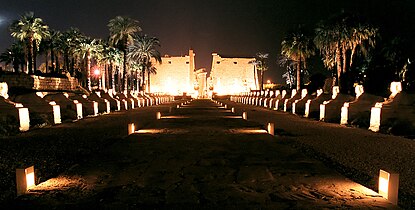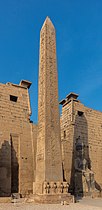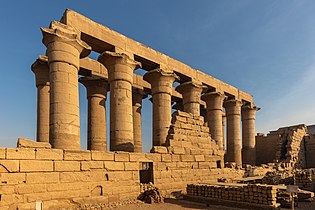Luxor Temple
 Entrance of the temple (first pylon) | |
| Location | Luxor, Luxor Governorate, Egypt |
|---|---|
| Region | Upper Egypt |
| Coordinates | 25°42′0″N 32°38′21″E / 25.70000°N 32.63917°E |
| Type | Sanctuary |
| Part of | Thebes |
| History | |
| Founded | 1400 BCE |
| Site notes | |
Ancient Thebes with its Necropolis | |
| Criteria | Cultural: (i), (iii), (vi) |
| Reference | 87-002 |
| Inscription | 1979 (3rd Session) |
| Area | 7,390.16 ha (28.5336 sq mi) |
| Buffer zone | 443.55 ha (1.7126 sq mi) |
The Luxor Temple (
To the rear of the temple are chapels built by
Along with the other archeological sites in Thebes, the Luxor Temple was inscribed on the
Construction
The Luxor Temple was built with sandstone from the Gebel el-Silsila area, which is located in South-Western Egypt.[4] This sandstone is referred to as Nubian sandstone.[4] It was used for the construction of monuments in Upper Egypt as well as in the course of past and current restoration works.[4]
Like other Egyptian structures, a common technique used was symbolism, or illusionism.[5] For example, to the Egyptian, a sanctuary shaped like an Anubis jackal was really Anubis.[5] At the Luxor Temple, the two obelisks (the smaller one closer to the west is now at the Place de la Concorde in Paris) flanking the entrance were not the same height, but they created the illusion that they were.[5] With the layout of the temple they appear to be of equal height, but using illusionism, it enhances the relative distances hence making them look the same size to the wall behind it. Symbolically, it is a visual and spatial effect to emphasize the heights and distance from the wall, enhancing the already existing pathway.[5]
Excavation
From the Middle Ages, the population of Luxor had settled in and around the temple, at the southward end of the mount.[1] Due to this, centuries of rubble had accumulated, to the point where there was an artificial hill some 14.5 to 15 metres (48 to 49 ft) in height.[1] The Luxor Temple had begun to be excavated by Professor Gaston Maspero after 1884, once he had been given permission to commence operations.[1] The excavations were sporadic until 1960. Over time, accumulated rubbish of the ages had buried three quarters of the temple which contained the courts and colonnades which formed the nucleus of the Arab half of the modern village. Maspero had taken an interest earlier, and he had obtained the post of Mariette Pasha to complete the job in 1881. Not only was there rubbish, but there were also barracks, stores, houses, huts, pigeon towers, which needed to be removed in order to excavate the site. (There still exists a working mosque within the temple which was never removed.) Maspero received from the Egyptian minister of public works the authorization needed to obtain funds in order to negotiate compensation for the pieces of land covered by the houses and dependencies.
Festivals

The Luxor Temple was built during the
Avenue of Sphinxes and Shrine stations

The avenue (known as wi.t ntr "path of god"; طريق الكباش)
A small mudbrick shrine was built in the courtyard of Nectanebo I in early second century (126 CE) and was dedicated to Serapis and Isis; it was presented to Roman Emperor Hadrian on his birthday.[10]
Abu Haggag Mosque

The active Abu Haggag Mosque (مسجد أبو الحجاج بالأقصر) is located within the temple, standing on the ancient columns themselves. That part of the Luxor Temple was converted to a church by the Romans in 395 AD, and then to a mosque in 640, which is more than 3,400 years of continuous religious worship.[11]
Defacement
In 2013, a Chinese student posted a picture of engraved graffiti that read "Ding Jinhao was here" (
Gallery
-
Sanctuary of Luxor Temple
-
Sun court of Amenhotep III
-
The Avenue of Sphinxes at night
-
Pylon and Obelisk of Ramses II
-
The Grand colonnade
-
Barque Shrine of Theban Triad
-
First pylon at night
See also
References
- ^ a b c d Science, "Excavation of the Temple of Luxor," Science, 6, no. 6 (1885): 370.
- ^ "Chapel of Imperial Cult". Madain Project. Retrieved 10 April 2019.
- ^ "Ancient Thebes with its Necropolis". UNESCO World Heritage Centre. United Nations Educational, Scientific, and Cultural Organization. Retrieved 7 September 2021.
- ^ a b c Bernd Fitzner, Kurt Heinrichs, and Dennis La Bouchardiere, "Weathering damage on Pharaonic sandstone monuments in Luxor-Egypt," Building and Environment, 38 (2003): 1089.
- ^ a b c d Alexander Badawy, "Illusionism in Egyptian Architecture," Studies in the Ancient Oriental Civilization, 35 (1969): 23.
- ^ a b Lanny Bell, "Luxor Temple and the Cult of the Royal Ka," Journal of Near Eastern Studies, 44, no. 4 (1985): 251.
- ^ Martina Minas-Nerpel (2018). "Pharaoh and Temple Building in the Fourth Century BCE" (PDF). Heidelberg University. p. 133.
- )
- ^ a b c d e f Charles Nims, "Places about Thebes," Journal of Near Eastern Studies, 14, no. 2 (1955): 114.
- ^ "Chapel of Serapis". Madain Project. Retrieved 26 May 2019.
- ISBN 9781444780543. Retrieved 21 August 2019.
- ^ Hiufu Wong, CNN (27 May 2013). "Netizen outrage after Chinese tourist defaces Egyptian temple". CNN.
{{cite news}}:|author=has generic name (help)









